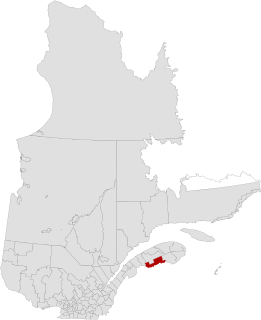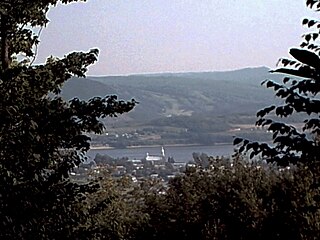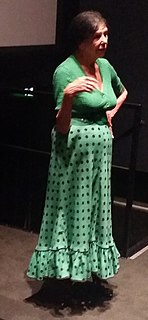The Miꞌkmaq language is an Eastern Algonquian language spoken by nearly 11,000 Miꞌkmaq in Canada and the United States out of a total ethnic Miꞌkmaq population of roughly 20,000. The word Miꞌkmaq is a plural word meaning 'my friends' ; the adjectival form is Miꞌkmaw. The native name of the language is Lnuismk, Miꞌkmawiꞌsimk or Miꞌkmwei.

Avignon is a regional county municipality located in the Gaspésie–Îles-de-la-Madeleine region of Quebec, Canada. The seat is Nouvelle. Its largest city is Carleton-sur-Mer.
Indigenous peoples in Quebec total 11 distinct ethnic groups. The 10 First Nations and the Inuit communities number 141,915 people and account for approximately 2% of the population of Quebec, Canada.

The Restigouche River is a river that flows across the northwestern part of the province of New Brunswick and the southeastern part of Quebec.
Restigouche, deriving from the Míkmaq name Listuguj, is the name of several geographic and political features in northern New Brunswick and neighbouring Quebec:

Atholville is a village in Restigouche County, New Brunswick, Canada.

William "Willie" Dunn was a Canadian singer-songwriter, film director and politician. Born in Montreal, he was of mixed Mi'kmaq and Scottish/Irish background. Dunn often highlighted aboriginal issues in his work.
The Burnt Church Crisis was a conflict in Canada between the Mi'kmaq people of the Burnt Church First Nation and non-Aboriginal fisheries in New Brunswick and Nova Scotia between 1999 and 2002.

Pointe-à-la-Croix is a municipality located on the Restigouche River in the Gaspésie region of eastern Quebec, Canada. It is situated across from the city of Campbellton, New Brunswick.

Gesgapegiag is one of two First Nations reserves on the south shore of the Gaspésie, most of whom are of Mi'kmaq ancestry. Most of the members reside on the federal Indian reserve that was set aside by the legislature of Lower Canada in 1853, for the exclusive use of the majority of Mi'kmaq in this region. The remaining Mi'kmaq live off-reserve in the eastern United States and across Canada, but stay connected to the community through modern communications and travel to. All community members, regardless of residence, participate in democratic elections held every two years to elect one Chief and eight Councillors in accordance with Canada's Indian Act Election Regulations. The community is also allied to other Mi'kmaq communities in the Gaspé region of Quebec and in northern New Brunswick. Together, their elected Chiefs advance ancestral claims to self-government and to the traditional territory called Gespe'gewa'gi ('Kespékewáki), the last land.
The Qalipu Mi’kmaq First Nation, is a band as defined by the Indian Act, created by order-in-council in 2011 pursuant to the Agreement for the Recognition of the Qalipu Mi’kmaq Band. It represents the Qalipu Mi'kmaq of Newfoundland and Labrador. The band does not control any reserve lands.
The Mi'gmawei Mawiomi Secretariat is a political organization and a tribal council representing the Mi'gmaq people of Gespe’gewa’gi, the 7th district of Mi'gma'gi, the national territory of the Mi'kmaq. The territory of Gespe’gewa’gi includes eight Mi'gmaq communities. The tribal council of Mi'gmawei Mawiomi is composed of three Indian bands: Gesgapegiag, Gespeg and Listuguj. Together the three bands has a cumulative registered population of 6,295 members in 2016. The organization is headquartered at Listuguj.

Micmacs of Gesgapegiag are a Mi'gmaq First Nation in Quebec, Canada. They are based at Maria, Quebec on the Gaspé Peninsula and they have one Indian reserve, Gesgapegiag. In 2016 the band has a registered population of 1,501 members. The First Nation is part of the Mi'gmawei Mawiomi Secretariat.

















